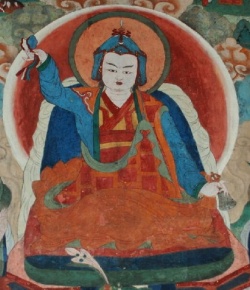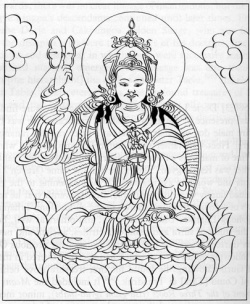Dorje Lingpa
Click here to see other articles relating to word Dorje Lingpa
Dorje Lingpa (Wyl. rdo rje gling pa) (1346-1405), the third of the five sovereign terma revealers, was an emanation of King Trisong Detsen and of the great translator Vairotsana. He was born in Tranang Entsa in Central Tibet. In his thirteenth year he had seven visions of Guru Rinpoche.
He found his first terma behind the Jomo statue of Tara in the Tradruk temple. In his fifteenth year in a cave at the Ökar rock, when Guru Padmasambhava came to him in person and granted him empowerment, he revealed many termas. Altogether he discovered 43 great terma troves and met Guru Rinpoche, Yeshe Tsogyal, Vairotsana and other such masters on numerous occasions.
The foremost of his termas is the Trilogy of Lama, Dzogchen and Avalokiteshvara (Wyl. bla rdzogs thugs gsum). He also revealed wonderful images and blessed substances, as well as Bön treasures, texts on medical science and astrology.
The name under which he is best known is Dorje Lingpa, but he is also called Pema Lingpa, Kunkyong Lingpa[1], Yungdrung Lingpa and Jampel Chökyi Shenyen.
After he passed away, his corpse remained for three years without decay, during which time it continued to benefit beings by speaking and reciting four-line dedications of merit.
When it was finally cremated, many sacred images and relics appeared. And with a roar of the flames his right foot flew from the crematorium and went to his spiritual son Tashi Jungne, and his left went to Tokmé Gyagarwa.
His lineage has persisted until today without decline, and some of his teachings have been preserved in a close lineage through Jamyang Khyentsé Wangpo.
Footnotes
- ↑ This was also the name of his immediate reincarnation
Further Reading
- Dudjom Rinpoche, The Nyingma School of Tibetan Buddhism, Its Fundamentals and History, trans. and ed. Gyurme Dorje (Boston: Wisdom, 1991), pages 789-792.
External Links
Source
Dorje Lingpa (rdo rje gling pa) was born in 1346 in Dranang Valley (grwa nang dben rtsa) in Tibet, into a family of yogis, and was given the name Orgyen Zangpo (o rgyan bzang po). His father’s name was Kuton Sonam Gyeltsen (khu ston bsod nams rgyal mtshan) and his mother was named Karmagyen (kar+ma rgyan). As both parents died when he was still very young he was raised by an aunt. At the age of eight he was given novice vows at Lharika (lha ri kha)
At thirteen he revealed his first treasure, from the imperial temple of Traduk (kra 'brug lha khang). Among the manuscripts he found there were the inventories (byang bu), to treasure concealed in other places.
At fifteen, he disclosed a large number of treasures at Namchagdrak (gnam lcags brag). Among these was the Tawa Longyang (lta ba klong yangs), a father tantra Dzogchen cycle is considered one of his more controversial and innovative teachings.
Also included were the Lama Kadu (bla ma bka' 'dus) and the Yidam Kadu (yi dam bka' 'dus).
These flourished in Kongpo and Kham, but ultimately died out, before being revived in the nineteenth century by Jamyang Khyentse Wangpo ('jam dbyang mkhyen brtse'i dbang po, 1813-1892).
Both survived in Bhutan, however, and the Lama Kadu is the ritual component of the annual festivals in several places in Bhutan today.
By the age of twenty Dorje Lingpa had revealed so many treasure teachings, on diverse subjects such as medicine, astrology, Bon, and various ritual practices, that Sokdogpa Lodro Gyeltsen (sog zlog pa blo gros rgyal mtshan) described him as a madman. Already at this point he was known by his treasure name, Dorje Lingpa.
Dorje Lingpa considered himself an incarnation of Vairocana, the eighth century Tibetan adept who is considered to have concealed both Buddhist and Bon treasures and figures prominently in the Dzogchen lineage of both traditions. In 1369 Dorje Lingpa was staying in the hermitage of Chuwori (cho bo ri) in the upper Yarlung Valley, where he obtained a second inventory to additional treasure, this one specifically tied to treasure concealed by Vairocana. In a dream a monk, whom he took to be Vairocana, gave him a bell and a vajra and, pointing with his finger toward the south, he said “O! your wealth portion and your would-be converts are down there, that way!”
Believing the dream to be a prophecy indicating treasure to be revealed in the region that is today Bhutan, he headed south, arriving in Paro in 1370 and began revealing treasure there. He continued on to Kotang Samten Rinchenling (mkho thang bsam gtan rin chen gling), known today as Kotangka, in Shar, one of the eight temples established by Longchenpa. He revealed further treasure in Namtang Langdrag (gnam thang glang brag) in Tang.
Around this time Dorje Lingpa originated the practice known as “public revelation” (khrom gter), in which an audience is invited to witness the extraction of the treasure object. In 1371, with three hundred people in attendance, he revealed treasure at Orgyen Yiblung Dekyiling (O rgyan yib lung bde skyi gling), and again at Pungtang (spungs thang).
In Bumthang several years later, he continued revealing treasure, building a residence that is said to exist today. He spent three years in Bumthang, revealing treasure, sitting retreats, and giving teachings based on his revelations.
In 1376 Dorje Lingpa returned to Tibet. Stories are told of the welcome he received in Tibet, following his sojourn in the reputedly barbaric regions of the south. For example, when visiting Barawa Gyeltsen Pelzang ('ba' ra ba rgyal mtshan dpal bzang) in the Shang valley, he was asked to please dress the part of a respectable lama, for fear that the clerics who were gathering to welcome him would loose faith. Dorje Lingpa arrived in a procession with women in tiger and leopard masks, and proceeded to sing a song of realization the topic of which was the tantric erasure of conventional dualistic thinking.
Such songs are a hallmark of Dorje Lingpa’s teaching, and many of them are preserved, written by multiple hands, in his collected works. For the next three decades he continued to teach, training numerous students including the Fourth Karmapa, Rolpai Dorje (kar ma pa 04 rol pa'i rdo rje, 1340-1383). He passed away at the age of sixty, and his corpse is said to have remained without decomposing for three years. His family lineage, through is son Choyingpa (chos dbying pa), continues in Bhutan.
Sources
- Samten Karmay. 2000. “Dorje Lingpa and His Rediscovery of the ‘Gold Needle’ in Bhutan.” Bhutan Studies Journal, Volume 2 No. 2: .
- Bradburn, Leslie, ed. 1995. Masters of the Nyingma Lineage. Cazadero: Dharma Publications, 1995.
- Dudjom Rinpoche. 2002. The Nyingma School of Tibetan Buddhism. Translated by Gyurme Dorje and Matthew Kapstein. Boston: Wisdom.
- Karmay Samten. 1998. The Great Perfection. Leiden: Brill, 216 ff.
- ’Jam mgon kong sprul blo gros mtha’ yas. 1976. Gter ston brgya rtsa. In Rin chen gter mdzod chen mo Paro: Ngodrup and Sherab Drimay, p. 79B.2. ff.
- Karma mi ‘gyur dbang rgyal. 1978. Gter bton brgya rtsa'i mtshan sdom gsol 'debs chos rgyal bkra shis stobs rgyal gyi mdzad pa'i 'grel pa lo rgyus gter bton chos 'byung. Darjeeling: Taklung Tsetrul Rinpoche Pema Wangyal, Orgyan Kunsang Chokhor Ling, p. 127.4 ff.
Alexander Gardner
December 2009
Source
The following biography is from the Treasury of Lives, a biographical encyclopedia of Tibet, Inner Asia and the Himalaya. The biography is written by Alexander Gardner.
http://www.treasuryoflives.org/biographies/view/Dorje-Lingpa/8750


